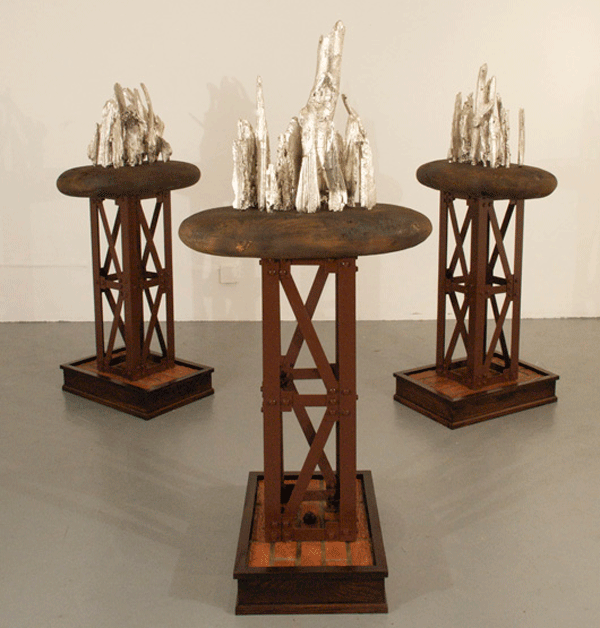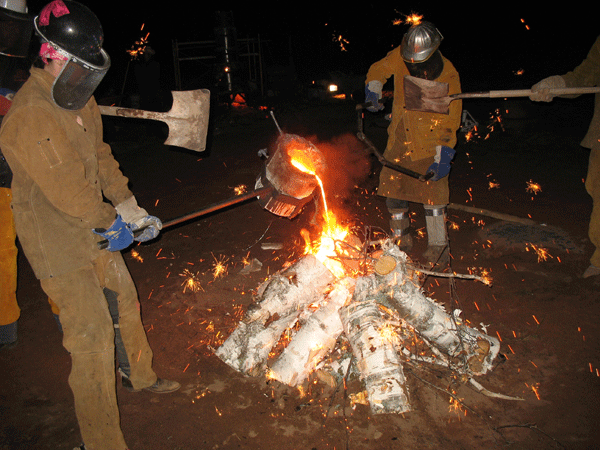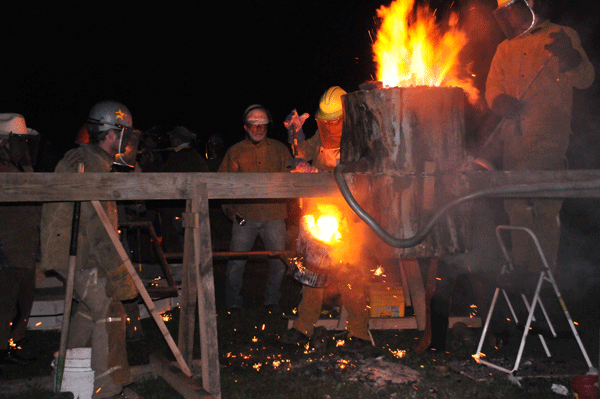

If you’ve ever witnessed an iron pour, you know it’s hard to watch one without your inner pyromaniac wanting to give it a try. Artist Joe Sandor gave us a window into the DIY iron pour community in MAKE Volume 23‘s “Social Slag,” and demonstrated a pour with a crew from the Chicago Crucible at Maker Faire Detroit 2010. The demonstration was mesmerizing, watching chunks of reclaimed iron get melted down to a red-hot stream and then poured into molds. We recently caught up with Joe to get more detail into how he got involved in the community, what makes a good pour, and some interesting tales of salvage.
1. How did you first get interested in iron pours? How did you then get involved in the community?
After I finished college, I traveled a lot and played around with art while experimenting with some corporate America jobs that were never really satisfying. I was too impatient to sit in an office and be a paper pusher. (I had a political science degree but I had no idea how to get a job, and I really wanted to build things but I had no idea how to do that so I just started buying how-to books and as many tools as I could get my hands on.)
So I set up my own sculpture studio and knew some people in the local art scene (Duluth, MN) who told me about some sort of “radiator melt,” as it was known up there, that was happening at a local Wisconsin farm. I didn’t really know anything about how it was done or how I could even make a piece of art at this event, but I was intrigued. I never made it to that pour but it piqued my interest, and when I went to art school in Chicago, I devoted most of my time to the foundry where I eventually got involved in the school’s annual iron pour. After that, I pretty much lived the next three years learning foundry and traveling to different foundries and pours and learning different casting methods from as many different metal casters as I could find.
2. Describe the iron-pouring community.
The iron-pouring community is mostly a community of metal heads and pyromaniacs. Some use the term “artist,” but really we are all repressed industrial metal workers that missed the glory of the industrial revolution and never had the opportunity to work in a steel mill so we have to come up with our own excuses to weld things together and melt metal into new forms. And there is definitely a satisfying power in manipulating something as strong as iron. When the first metal casters discovered that you could take a super hard material and create hard durable tools that could hold an edge and react to hot and cold the way it does, they discovered a power to manipulate their environment and that made life easier and enjoyable. I think the contemporary iron pouring community is composed mostly of people who began as artists and settled into cast metal art.
A lot of people work in other metals, like bronze, which is more practical and traditional for sculpture methods but is expensive, or they use aluminum, which is lighter and cheaper but not as durable. They come to iron because the pours are fun. Yes, the metal is free (or costs a minimal donation for scrap cost), but it does require a lot of labor, and when we work as a community we can reduce that labor so that we can enjoy the pour. I think you could break it down to this: there are some artists who use iron as an excuse to make art, and there are some metal heads who use art as an excuse to play with iron, but the best use both to make really cool things. And don’t forget all of the iron pour performance groups. That’s a whole separate story.
3. Where are your favorite places to salvage materials? Chicago is such a great city, there must be some gems.
Scrapyards in Michigan and Indiana, the not-so-scenic-armpit parts of Chicago that is, seems to be where most of my experience has been. Usually we call up a scrapyard and tell them what we do, and they’ll set a few hundred pounds worth of iron (“cast” as they call it) radiators, sinks, bathtubs, brake drums, etc. Sometimes, we’ll get word that a building is being remodeled, and if they’re modernizing their heating system, then that usually means there might be a few radiators we can free the building of. There’s almost always someone who has an old radiator, tub, or sink sitting in their garage or backyard, and it’s our job to find them, sometimes through Craigslist or usually word of mouth. Swap-o-Rama, Maxwell Street, and Otis-Oakley Iron and Steel surplus are a few resale places in Chicago.
4. What’s the most unexpected place you’ve salvaged materials from?
Honestly, Maker Faire Detroit was one of the more interesting iron-getting experiences. I called up some scrapyards ahead of time and found a donor. The problem was that the guy didn’t understand what sort of metal works best for us, so he didn’t save any radiators or tubs (the easy stuff to break and melt). He had a couple thousand pounds worth of cast brake drums and told me we could have as many as I wanted, but they were too thick, which meant that we couldn’t break them with our hammers, and they would be too thick to melt in our small furnace.
So I ended up digging deep in their scrapyard and found a couple of cast pipes, some old ornate cast gates, a nice old cast iron Singer sewing machine housing, and luckily some scrappers were dropping off a big enameled cast iron sink as we were leaving, which we pulled off their truck. I should note here that we usually use radiators and tubs because they are about 1/8″ thick, and they break apart easy with a sledgehammer. Once you can break them down to small pieces, you can melt them down. So if it’s really thick metal, it won’t break, at least not by our hands. So I managed to get about a third of the metal we needed for the following day’s pour.
Back at the Henry Ford museum, one of the museum workers told me there might be some old metal I could use back in their shop. So we hopped on his cart and he took us on an iron adventure, which took us to the building where they were working on Henry Ford’s personal steam engine. That was cool, but we only found about 10 pounds of iron from an old table brace. So that night, I was scheming to find some abandoned buildings in Detroit and bust out their iron, but fortunately I met some guys from the local university who run iron, and they told us we could have some of their knuckles. (Knuckles are the bits of radiator that are attached to the steel ring which holds each section together. It’s really hard to get off and you can’t put it in the furnace because the steel will damage the furnace.)
5. Do the scrap pieces have to be cleaned before being melted? What are your favorite salvaging and cleaning tools?
No, they don’t have to be cleaned, but you need to wear dust and face protection (i.e. respirator, safety glasses, face shield) when you break them to size. Some of these old radiators have asbestos and other bad bits of dust which should be avoided. For salvaging, a sledge hammer, good gloves and maybe a Sawzall. For cleaning the metal, it’s all about the elements: earth, wind, and fire. We use limestone as a flux to promote a clean melt, and we use air to control the temperature of the fire inside the furnace. If you do all of this properly during the pour, the slag (all the bad stuff from the old metal) will shoot out the side, and clean, pure molten iron will come out of the bottom. Fire cleanses all.
6. What’s the grossest thing you’ve come across in your salvaging adventures? What’s the coolest/most unique thing you’ve found?
We once payed a guy $150 for 10 enameled bathtubs. We drove a couple trucks out to his place, and it was a classic white trash empire with miles of junk spread out on picturesque Wisconsin rolling green hills. He took us to the spot but we couldn’t get the truck too close because it was super muddy, so we had to stand in the mud and smash the tubs in half and throw them to the truck to get loaded. So we were standing amongst mud and a million pieces of broken glass enamel that was breaking off.
7. Iron pours are usually two-day events. What makes for a successful pour?
Like any good event, it’s all about being prepared and good people making decisions. You need enough people to do all of the hard physical labor so that it not too much for one or two people. You need people who know how to run a furnace, and one person will tell the furnace crew what to do. Access to trucks, forklifts, and any sort of heavy machinery is a plus. Up in Wisconsin, we have front loaders, excavators, and some other Caterpillar-type machines that make life easier, and we can cast really big pieces. The less you have to use your limited human abilities and the more you can give to a machine, the happier you will be pouring metal. Metal is heavy, and machines are our friends. When people are organized and no one person has to break all of the iron, and no one person has to charge the furnace alone, and no one person has to fill all of the molds, then no one is overworked, and we all have a good time.

8. What advice do you have for folks who are interested in getting involved in pours?
Go on YouTube and search “iron pour.” A lot of schools put up demos of their work. Find that school and seek a mentor. Otherwise contact me, or www.chicagocrucible.com is another resource. For anyone wanting to go the collegiate route, I would advise contacting the sculpture department of any university and finding out what their foundry does. I know University of Minnesota, U.W. Stevens Points, the School of the Art Institute of Chicago, or Georgia State University all have really dedicated iron casters. Or you can go directly to Sloss Furnaces in Birmingham, Ala., and you could probably be pouring metal within 48 hours of arrival.
This post sponsored by Dial for Men. During “30 Days of Dirt,” Dial for Men will be giving away over 400 prizes. To find out more, head over to Facebook.com/DialForMen for your chance to win grand prizes like a Polaris ATV, dirt bike, and riding lawnmower, or any of the daily prizes, like $50 gift cards to stores like Home Depot, Sears, Cabela’s, and Lowes, Dial For Men product coupons, and Dial For Men T-shirts.
ADVERTISEMENT







